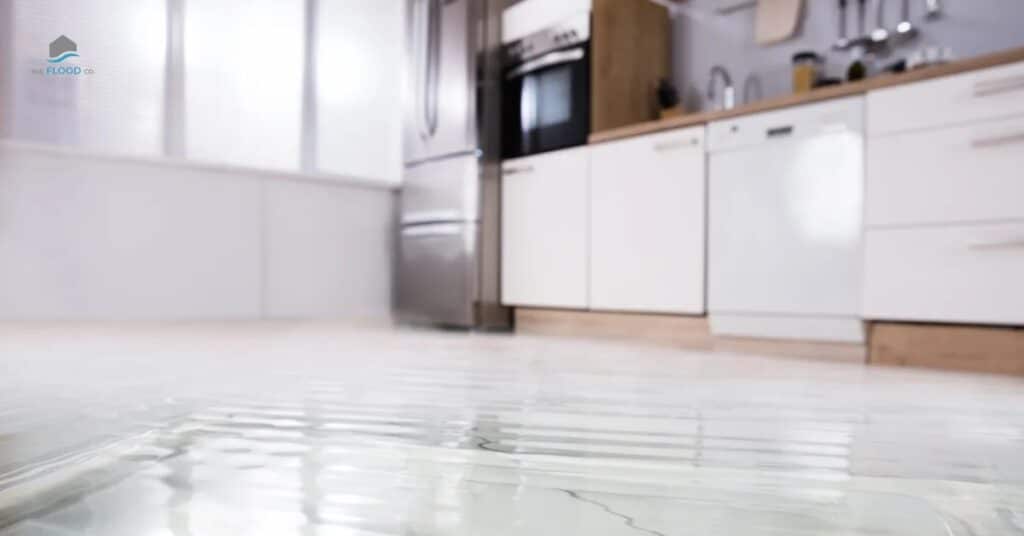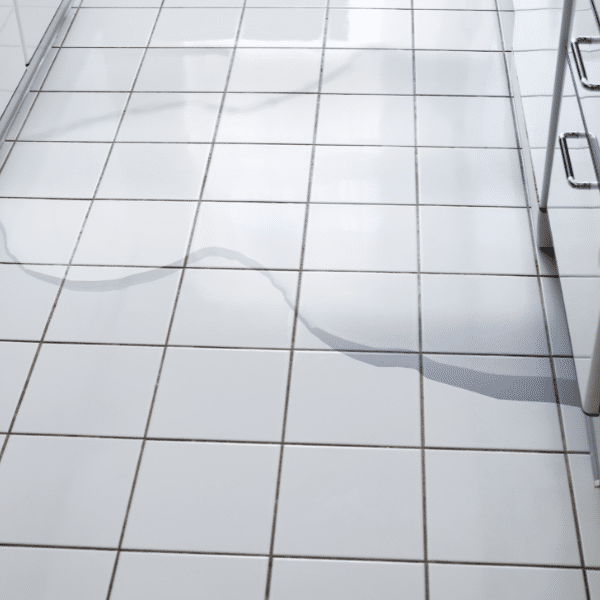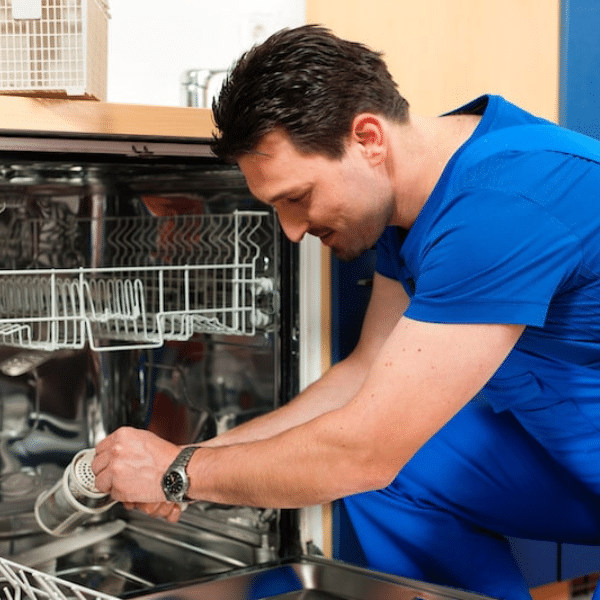
Why Your Dishwasher Might Be Leaking (And How to Stop It Before It Gets Worse)
A small puddle on the kitchen floor can feel like nothing to worry about. However, that slow drip under your dishwasher may be quietly seeping into your floors, cabinets, and subfloor, setting the stage for costly water damage and mold growth.
If you’re in Utah and just discovered a dishwasher leak, you’re not alone. At The Flood Company, we’ve seen hundreds of “small leaks” turn into major restoration projects. This guide breaks down the most common hidden causes of dishwasher leaks, what signs to watch for, and when it’s time to call in the pros before your floors are ruined.
7 Common Causes of Dishwasher Leaks
Dishwasher leaks often look simple, but they’re usually caused by small mechanical failures that allow water to escape over time.

1. Worn or Cracked Door Gasket
The rubber gasket around your dishwasher door keeps water sealed inside during wash cycles. Over time, it can harden, crack, or lose its shape, allowing water to leak out.
Fix: Inspect the gasket for cracks, mold, or buildup. Clean it with warm soapy water or replace it entirely if it’s damaged.
2. Loose or Leaky Hose Connections
Dishwashers have several hoses such as supply, drain, and circulation. Even one loose clamp or old fitting can lead to a steady leak behind the appliance..
Warning signs:
Damp spots or discoloration behind the dishwasher
Musty odors near the floor
Softened baseboards or warped flooring
Tighten hose connections and replace worn clamps immediately
3. Cracked or Damaged Hoses
Hoses exposed to constant heat and pressure eventually weaken and split. These cracks often leak only during operation, which makes them easy to miss.
If your dishwasher is older than 10 years, replacing all hoses as preventive maintenance is a smart move.
4. Faulty Water Inlet Valve
The inlet valve controls how much water enters your dishwasher. If it malfunctions, water can overflow from the base pan or leak inside the unit.
You might notice:
Standing water after a cycle
Overflowing during filling
A hissing or dripping noise when the dishwasher is off
A professional should inspect and replace the valve if needed.

5. Leaking Pump or Seal
A dishwasher pump circulates water throughout the wash cycle. When its internal seals wear out, water can leak from the bottom center of the unit.
Rust or pooling water directly beneath the machine often means a failing seal.
6. Incorrect Detergent Use
Using regular dish soap creates excess suds that spill out around the door. It might look harmless, but repeated overflow can cause moisture damage around your cabinets and flooring.
Stick to dishwasher-safe detergent and avoid overfilling the dispenser.
7. Damaged Tub or Internal Components
Old dishwashers sometimes develop cracks inside the stainless steel or plastic tub. These slow leaks can allow water to run beneath flooring and cabinetry before you ever see a puddle.
Once cracks form, replacement is usually the only fix.
How to Spot a Hidden Dishwasher Leak Before It Becomes a Disaster

Leaks that start under your dishwasher can stay hidden for weeks. Here’s how to catch them early.
✅ Use a flashlight to check under and behind the unit.
✅ Look for warped flooring, bubbling laminate, or darkened wood.
✅ Pay attention to musty smells, especially near the kick plate.
✅ Listen for faint dripping sounds after the cycle ends.
Even small signs of moisture mean it’s time to act. Once materials stay damp for more than 48 hours, mold growth begins.
Why Ignoring a Dishwasher Leak Gets Expensive
Water doesn’t stay put. It travels under flooring, into walls, and beneath cabinets. When you ignore a leak, the repair costs multiply quickly.
Here’s what usually happens:
Day 1–2: Water spreads under flooring and cabinetry.
Day 3–5: Mold starts growing in dark, hidden spaces.
Day 7–10: Structural materials begin to rot.
By the time the damage is visible, restoration often involves tearing out flooring and drywall. Early action is the only way to avoid thousands in repairs and stressful insurance claims.
How Professionals Fix Dishwasher Leak Damage
At The Flood Company, we’ve spent over 20 years helping Utah homeowners recover from kitchen leaks and water damage. Our team combines expertise with advanced tools to quickly identify and resolve moisture issues.
Here’s what our process looks like:
Moisture Detection: We utilize infrared cameras and moisture meters to identify concealed water beneath floors and behind walls.
Water Extraction: Industrial vacuums and pumps remove every drop of standing water.
Drying and Dehumidification: Targeted airflow and dehumidifiers remove deep moisture to stop mold growth.
Restoration: We repair damaged flooring, drywall, and cabinetry, returning your kitchen to pre-damage condition.
It’s a proven process that saves homeowners time, money, and frustration.
Building Trust Through Experience
We understand that dealing with water damage is stressful. That’s why our approach focuses on empathy and clarity, not scare tactics.
The Flood Company has restored hundreds of homes in Utah after dishwasher leaks, pipe bursts, and basement floods. We work directly with insurance providers and offer zero-down billing for covered claims.
Every project is handled by certified technicians who treat your home like their own.
Ready to Take the Next Step?
If you’ve spotted a leak, don’t wait for mold to appear. A quick call today can prevent a major restoration later.
Contact The Flood Company for a Free Water Damage Assessment.
We’re available 24/7 for emergencies and offer free phone consultations for water or fire damage events.
Let’s get your kitchen back to normal as soon as possible.
Frequently Asked Questions
A dishwasher leak becomes serious as soon as water escapes the appliance enclosure. Even a few ounces of water can seep beneath flooring or into the subfloor, where it’s trapped out of sight.
Early indicators include warped planks, dark stains on wood, soft or spongy flooring, and a faint musty smell. Once you see those, it’s no longer a surface issue. It becomes a hidden moisture problem that requires professional drying and restoration.
Most policies cover sudden and accidental leaks, such as a burst hose or failed valve. However, they often exclude gradual damage caused by long-term neglect or slow drips that weren’t reported quickly.
The key is documentation. If you suspect a leak, take photos, note the date you discovered it, and contact both your insurance company and a licensed restoration expert, such as The Flood Company. We can help confirm the source, document the damage, and guide you through the claim process.
Mold can begin forming within 48 hours in a damp, unventilated space. Kitchens are particularly vulnerable because wood, insulation, and drywall all retain moisture easily.
The longer water remains trapped, the more spores multiply. Professional drying and dehumidification within the first 24 to 48 hours can prevent the growth of full-blown mold, thereby protecting your indoor air quality and structure.
You can mop up visible water, but what matters most is the hidden moisture under your flooring and behind walls. Even if the surface feels dry, subfloor materials can hold water for days.
Without commercial drying equipment and moisture meters, it’s impossible to confirm complete dryness. That’s why DIY cleanup often leads to recurring mold or structural issues later. Hiring a professional ensures complete moisture removal and documentation for insurance purposes, if needed.
Not always. If the leak was caused by a loose hose or a bad gasket, the dishwasher may still be perfectly fine once repaired. The bigger concern is whether the surrounding flooring and cabinetry were damaged.
If the appliance itself is older or shows internal cracks, replacing it may be the safer long-term choice. In most cases, addressing the water damage around it is the first priority.
A few simple maintenance habits go a long way:
Inspect hoses every six months for cracks or wear.
Clean the door gasket regularly with mild soap.
Avoid overloading your dishwasher or using excess detergent.
Run a short cycle and check for leaks after any maintenance or moving.
Prevention is far easier and cheaper than restoration.
Get Ahead of Dishwasher Leaks Before They Spread
Leaks start small, but the damage can grow quickly.
If you notice water near your dishwasher or warped flooring, act quickly before mold and rot set in.
The Flood Company can help you pinpoint the cause, stop the damage, and restore your home while working directly with your insurance to minimize stress and cost.
Call (801) 316-8362 or schedule your free water damage inspection today.
- What Causes Dishwasher Leaks? 7 Hidden Issues That Could Be Ruining Your Floors - October 29, 2025
- Is It Possible to Fully Remediate Mold? - October 29, 2025
- What Does a Disaster Restoration Company Do? - October 12, 2025

